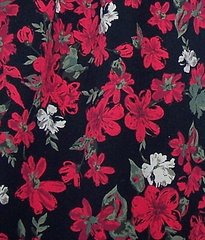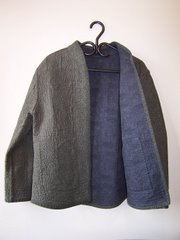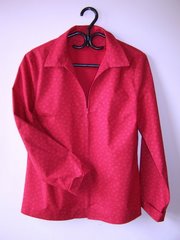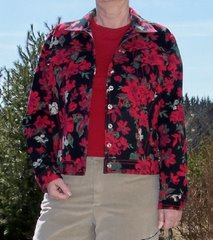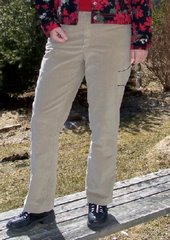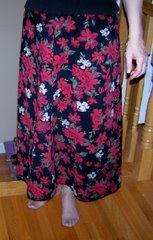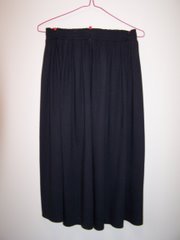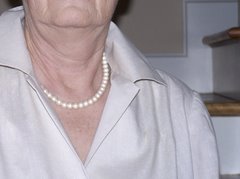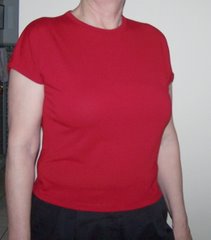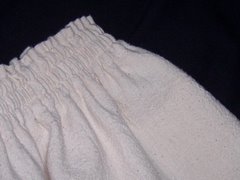 Post SWAP update: April 18, 23, 26, 27.
Post SWAP update: April 18, 23, 26, 27.[For the SWAP click here]
It's April 18. What's been happening since SWAP?
It's been a while since I posted. I have done a little sewing, but mostly I've been doing some planning for the next phase.
I have ruined one attempted top of ivory panne velour. It turned out too small. Not enough stretch for the pattern. No great loss.
I have completed the unfinished muslin jacket of ivory Malden Mills fleece. It still needs pockets, or some sort of embellishment, but it is wearable. I used bathing suit lining for the binding, but I didn't do a great job of it. It's cuddly stuff -- the fleece, not the binding -- and feels good on these cold damp April days we're having here. Good enough for around the house, or walking in the evenings. I made it to have something visible for walking at night.
I also started some of the touch-ups required on my SWAP garments:
- The One-Seams got taken in, and I did that yesterday. They were too low in the crotch, and the legs too full. The fabric is quite heavy. I took in about an inch all the way up the leg seam on both sides.
- The red shirt cuffs do not feel right, so I'm taking them off and putting a facing on the outside of the sleeve bottom instead, and
- the pockets of my reversible jacket really should be removed, and get binding all around instead of having the bottom edge turned under. An oversight at the time while rushing. None of these things interferes with wearing the clothes, but I will feel better when they're done.
I want to start working with silk and I have quite a collection gathered. I still have no idea, however, about what patterns to use. Mostly I will have to make muslins I presume to get everything in order before starting on a silk version. The April Burda WOF has some possibilities. The Stitchers Guild has a silk thread on the go, as well as a Chanel-type jacket thread. Both interesting possibilities, though I don't think I would have occasion to wear the jacket.
Meanwhile, I think I will work toward some SWAP complimentary pieces until I get a new color scheme worked out. I have lots of fabric purchased for SWAP that was not included for various reasons, but which will go with some of the SWAP pieces nicely.
- Red Wool Crepe (2m)
- Olive Stretch Corduroy (2+m)
- Olive Faux Suede (1.5m or maybe less)
- Green/Ivory cotton far out print (2m or so)
- Ivory bamboo knit (3m)
- Gold dupioni with bees on it (1.5m)
- Green dupioni (2m)
- Sage green polyester (1.5m) junky stuff from Walmart, probably won't use it.
- Taupe stretch corduroy matching SWAP pants (1m or so)
- AND I really need a nice pair of black pants in a summer weight - no fabric on hand for that.
Just before our weekend road trip I fixed the cuffs on the red shirt, and partially cut out green stretch corduroy pants using April 07 BWOF #120. I compared the pattern with the one I used for my taupe pants, and they were close enough to be twins. These are billed as "narrow" but in fact they are about half an inch wider in the leg than the ones already made. I wanted a new pattern to avoid the V-shaped yoke in the back that unnecessarily emphasizes my butt. Hopefully later today, I'll get to work on those pants.
I learned that stretch cord can be marked with a tracing wheel and no paper. The marks don't stay on forever, but its better than getting all that chalk all over the place.
I also learned that rubbing alcohol will remove interfacing glue from my iron. I fully 'fused' a piece of interfacing wrong way up. There are other products mentioned on the forum in response to my question posed there.
On our trip to Nova Scotia we found an off-the-beaten-track sheep farm with delicious yarns, and a few other interesting items, like hand-made wooden knitting needles. I'm not a knitter, but I bought some roving and felting needles to experiment with on the ivory fleece jacket. Another new thing to try.
It's April 26-27: Green stretch cords underway

I've been working exclusively on the green cords (except for buying 6 Simplicity patterns on sale -- not sure how they will work as they will all need a bust and back length adjustment. These are to help me work away my stash of silks and knits)
The pants are going well, but this pattern is weird, weird, weird. The front of the pants from fly to pocket is higher than the rest of the pant pieces, (ie no waistband in that part). The waistband is fitted into the remaining front and continues around to center back, then a facing is sewed to the top of the whole thing and turned under.
 Sounds simple except that the waistband is attached where the pocket opening starts, which means there are already several layers (pocket facing, pocket yoke) to contend with, and now the waistband, and at the top, the facing. This is stretch corduroy and the thickness is quite unmanageable, especially considering this is supposed to be topstitched close to the top edge. I also think the seam joining the front to the waistband should be turned onto the waistband, and not onto the front as suggested in the pattern directions. This would add 2 more layers in that lump that has to be folded over when the facing is turned back.
Sounds simple except that the waistband is attached where the pocket opening starts, which means there are already several layers (pocket facing, pocket yoke) to contend with, and now the waistband, and at the top, the facing. This is stretch corduroy and the thickness is quite unmanageable, especially considering this is supposed to be topstitched close to the top edge. I also think the seam joining the front to the waistband should be turned onto the waistband, and not onto the front as suggested in the pattern directions. This would add 2 more layers in that lump that has to be folded over when the facing is turned back. But that's not the biggest challenge. Burda directions for installing a fly are impossible to understand -- not the first time I fell back on an easy, fly attachment with no underflap. Also, the directions for applying the facing at the fly area are initially incomprehensible, so I spent a long time muttering and mumbling to myself about how to get the top edge looking good.
But that's not the biggest challenge. Burda directions for installing a fly are impossible to understand -- not the first time I fell back on an easy, fly attachment with no underflap. Also, the directions for applying the facing at the fly area are initially incomprehensible, so I spent a long time muttering and mumbling to myself about how to get the top edge looking good.The zipper does not go to the top. It stops at a mysterious "mark" 1.25" from the top edge and there is supposed to be a button-hole at the top. Interesting concept, but there seems to be nothing to attach the button to. Possibly, if I had installed the fly underflap, it would extend under the fly in such a way as to accomodate a button, but it would also have added another bunch of bulk right at the center front.
I finally figured out how to do the facing/fly attachment, which was quite logical after all, and it looks pretty good. Great on the front, ok on the inside.

I decided to just let the zipper come up to within a quarter inch of the top and put a hook there,maybe sewing on a button for show. Still, the zipper just "stops" with nothing to cover the top edge of it. I must have missed something there.I think this would be the case regardless of how I finished to facing or the underflap.
I've enjoyed the challenge of figuring this out (or rather, not figuring it out). I knew these pants would fit, and the pocket installation is flatter and simpler than in my SWAP stretch pants, whose pockets never did lie flat -- my fault most likely.
I think these pants would have been very difficult if alterations were required. The design of the top does not lend easily to basting and re-fitting. The curved partial waistband, and curved fitted facing do not have a side seam, and thus would not be happy getting their sizes changed, and matched again to each other.
There is supposed to be topstitching at the top of the waistband, through the facing. I topstitched first then turned the facing under. No way it would look good sunk through all those layers, especially in corduroy, which probably should not have been topstitched in the first place. The bottom of the band is also topstitched, and this I did through the facing to hold it down. Because of the design, there are no lumps to stitch through there.
Next round
- I would draft a waistband for the entire top of the pants, possibly giving it side seams to allow for adjustments later, or elastic in the back if they stretch out.
- The fly and zipper would be traditionally installed, with a button at the top. I need to study up on how the top fasteners work on pants. You would think a person who has worn pants for almost 60 years would know that, wouldn't you.
- I would make the pocket facings and the waistband facing from a stretch poplin or other lighter material, especially if using corduroy or similar weight fashion fabric







